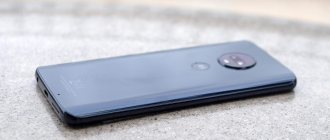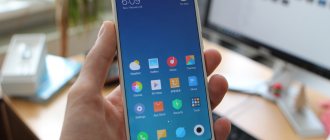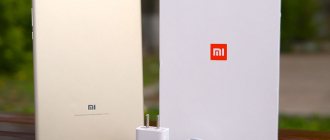Xiaomi's leadership in the Chinese smartphone market hardly surprises anyone. Gadgets from this manufacturer are widely known outside of China, although they can officially be sold only in a limited number of countries. Russia is one of the countries where you can buy an official smartphone from Xiaomi, which is good news.
With the advent of the Xiaomi Mi 3 model, a new trend has emerged in the flagship line of smartphones. Well, by and large, it was from the “troika” that the branch became the flagship. If previously the main goal was to create phones at a low price, even at the expense of quality or appearance, now the Chinese have begun to captivate the public with gadgets with powerful characteristics and a distinctive style.
So, it was with Mi 3 that the screen diagonal of the flagship line increased to 5 inches, and the Chinese company began to pay increased attention to the body of the device. Moreover, this applies both to its appearance and ergonomics, and to the materials used. It is not surprising that the “troika” quickly became popular, and the appearance of the Mi 4 was highly anticipated.
Compared to its predecessor, the “four” received improved technical characteristics, a metal body and an improved MIUI firmware shell. In addition, Mi 4 has already adequately competed with smartphones from much more famous manufacturers.
Today we will take a detailed look at all the features of the Xiaomi Mi 4 so that you can get the most complete impression of the phone.
Specifications
First, let's look under the cover of the gadget and find out what characteristics the Chinese flagship has. The Xiaomi Mi 4 smartphone has a quad-core chip from the Qualcomm Snapdragon family. However, unlike the previous version, in this case the processor version with a frequency of 2.5 GHz is installed. Although an improvement is declared in comparison with the Mi 3, in practice it is noticeable only in a small proportion of cases and during testing. In normal use, everything remains almost the same. But the overall operation of the device has accelerated, because it now has one gigabyte more RAM. For Xiaomi Mi 4 smartphones, 3 GB of RAM looks very impressive.
In terms of built-in memory, everything remains the same as in the Troika. You can purchase a smartphone in one of two configurations. In the first case, the size of its built-in memory will be 16 GB, and in the second – 64 GB. We advise you to estimate before purchasing how much hard drive space you will need, because while using the device, the memory card can no longer be used - the gadget simply does not support them.
Xiaomi Mi 4 configuration
The smartphone screen is identical in all respects to the Troika. The diagonal is 5 inches, Full HD resolution and IPS matrix. Everything is quite usual. The sensor detects up to 10 simultaneous touches, which indicates its extremely high sensitivity. Depending on the situation, this can be regarded as both an advantage and a disadvantage. I would like to see at least the ability to configure this setting via the menu. But the developers did not provide such a function.
As for data transmission, the smartphone supports 2G and 3G networks. It is possible to use only one micro-format SIM card. There are rumors that Haomi is seriously thinking about releasing a model that supports the 4G standard, which is already gaining popularity in the world.
You can connect to a computer or outlet via a charger using the familiar Micro-USB 2.0. Due to OTG support, it is partially possible to compensate for the lack of a memory card slot.
In terms of wireless controllers, there are no differences from the third Mi model. The Xiaomi Mi Four smartphone transmits data via Bluetooth 4.0, can work with a Wi-Fi network, and can also determine the user’s coordinates using GPS and Glonass. The system is equipped with an FM radio receiver. Among the new products, we note the appearance of an infrared port, with the help of which it is supposed to control any equipment in the house using only one application on the phone. A very interesting addition is also the presence of a step counter.
Smartphones usually have two cameras. The main one is 13 megapixels with autofocus and flash and the front one is 8 megapixels. A distinctive feature of this smartphone model is the improved quality of the front camera, which selfie lovers will definitely be happy about.
Camera description
Xiaomi Mi 4C cameras use Sony IMX258 or Samsung S5K3M2 matrices with a resolution of 13 MP. When shooting, you can use phase detection autofocus and LED flash. On the front panel there is a front camera with a resolution of 5MP F/2.0, which is used for communicating on social networks, taking selfies and is therefore equipped with a wide-angle lens (5 lenses, 85°, no autofocus). Both cameras lack optical stabilization.
The number of settings is minimal, but this does not affect the quality of the pictures. Most of the parameters are determined automatically, including even the age and gender of the subject.
The fourth model features Edge Tap technology. Its idea is that the side face without touch sensors is used as a shutter release for any of the cameras. The activation of this technology is indicated by an icon on the smartphone display. This innovation improves shooting conditions.
You can control the cameras using standard MIUI, Edge Tap or gestures. The entire interface is designed for inexperienced users. It is not possible to specify exact shooting parameters. Instead of specifying the image resolution, you can only select relative “low, medium, high” quality settings. Only in manual mode is it possible to select a number of shooting parameters - sensitivity, aperture, shutter speed. In other cases, only the scenario selection is carried out. Advanced photography enthusiasts may be disappointed by the inability to save images in RAW format.
The hardware capabilities allow you to shoot video at resolutions up to 1080p and at various speeds. The resulting video is smooth, without jerks or obvious artifacts. The noise suppression system has shown its effectiveness.
Contents of delivery
The fourth generation smartphone of the Mi line is no different from its predecessors in terms of equipment. A box made of recycled cardboard allows you to securely fix the device as usual. All kinds of inscriptions outside and inside are in Chinese, which is not surprising, because the manufacturer primarily focuses on the domestic market. But the most important points are still translated into English. This applies, for example, to technical specifications. So you can easily compare them with the information stated on the Internet.
The package includes a 5V 2A power supply that supports fast charging. Also included is a Micro-USB cable and a key for working with the SIM card tray. Please note that the standard charger has a “flat” plug, which will require the additional use of an adapter for Russian sockets.
Design and ergonomics
I’d like to start describing the appearance of the smartphone by saying that it is about 5 mm narrower and shorter than the Mi 3. On the other hand, the thickness has increased a little, but the manufacturers easily veiled this by giving the body an original shape. All this allows us to call Mi 4 one of the most compact smartphones with a screen diagonal of 5 inches or more.
The weight of the phone has increased by 10 grams, but this is easily explained by the presence of steel elements in the design. They are used on both sides. There are jumpers at the top and bottom ends that help highlight the wireless antennas and, in general, add originality to the appearance of the gadget.
Fashionistas will be pleased with the ability to change the back panel of the phone. There are, however, very few colors, or rather only two: black and white. At the same time, the manufacturer ruled out the possibility of any changes regarding the content of the phone. You will not be able to change the battery or additional SIM card, nor will the memory card fit into the configuration.
Externally, you are unlikely to be able to find any grooves for removing the back cover, but such a possibility is declared by the manufacturer. Apparently, to implement it you need to resort to the use of additional devices. Thanks to the absence of gaps and grooves, it is possible to maintain the familiar appearance of the phone - it is a one-piece monolithic body that looks in a classic style.
Due to the fact that the back surface of the phone is slightly convex, you can easily lift the phone from any surface with one hand. There is a protective glass on the surface of the screen, the manufacturer of which is not specified.
Immediately below the screen there are touch buttons. There are only three of them and they are familiar to everyone who has used Xiaomi phones. The button labels are clearly visible even without backlighting, but it is also provided for low-light conditions. In the settings you can adjust the duration of the backlight.
Just below the central button there is a status indicator, with which you will know about the charging status and missed notifications. Notification colors can be selected from seven options. The screen lock and volume buttons are, as usual, at the top right. They are made of metal and practically do not differ in texture and color from the frame. The main thing is that they are very easy to detect, and pressing occurs reliably and clearly.
On the left is a slot for a SIM card, which can be opened using the key included in the package. The SIM card tray is made of metal, and there are no questions about its durability. At the top end there is an IR port, as well as a headset jack. At the bottom there is an output for Micro-USB and a speaker grille.
Description of the Xiaomi Mi4c smartphone model
The company's model range is long, and its addition to various Pro, Plus, Max, Mix makes it difficult for the buyer to navigate this diversity. The abundance of parameters does not allow us to consciously understand what is the difference between the models and which of them best satisfies the needs of the consumer. Sometimes there is no understanding which name is the beginning of the line and which is its top.
The new products coming out have a modern design and a reasonable price compared to their analogues. The company constantly monitors the value and constantly adjusts it in accordance with the market situation.
The basic configuration 4c 16gb and 2 GB of memory was sold for $216, while the modification with 3/32 GB cost $247.
In the fourth model, the company made a clear emphasis on improving quality characteristics. The manufacturer is not afraid of potential reproaches for the similarity of the model with Apple products. All technical and design solutions recognized by the market are boldly implemented by the company.
In the MIUI control shell, icons, menus, and translucent blocks resemble those in Apple, and externally the device is similar to the Huawei Ascend P7. The main thing is not the coincidence of certain decisions, but the fact that since the fourth model, the company’s products have reached a level at which it successfully competes with leading brands on the market. Xiaomi Mi 4C is a new level of the company.
Screen Features
The screen provides decent viewing angles; color shifts are avoided even when the view deviates significantly from perpendicular to the screen. There is also a uniform distribution of brightness and tones of the white field. The contrast is about 735:1, which cannot be called the maximum. Due to the fact that color temperature changes minimally from one shade to another, it is possible to improve the visual perception of color balance. It is also important that the user can independently change the color balance by choosing one of the saturation and color temperature profiles.
The device is pleasant to use in any environment, because the screen has excellent anti-glare properties. If you are in the dark, you can reduce the brightness to an acceptable level. Among the advantages of the screen, we also highlight the presence of an oleophobic coating and the absence of an air gap between layers and flicker.
Among the shortcomings, we note only the insufficient stability of black when the gaze deviates from the perpendicular and excessive color gamut, the correction of which is impossible with standard means. In general, if we evaluate these characteristics in relation to the price category of the device, then, without a doubt, they look excellent.
Sound
Since the speaker is located at the bottom end, it cannot be blocked, no matter what location the device is in. Even if you play in landscape mode and place your hand on the speaker, the sound will still come from the rear panel, albeit with a loss of high frequencies.
Mi 4 cannot boast of good volume - according to this indicator, everything is at an average level. But with headphones the situation changes. The sound becomes much richer and richer. The user has access to an equalizer for individual settings of all parameters. You can also choose ready-made profiles for a particular type of headphone.
The main speaker and microphone leave a good impression. The noise reduction function is available when using the second microphone, which is located just above the rear camera. But this is only relevant for phone conversations. For other conversations, for example, via Viber or Skype, this is not possible.
We would like to mention the vibration alert. In Mi 4, you can configure it manually by choosing one of three standard operating levels.
Appearance and Design
Has many colors.
The front panel is covered with glass, under which there are 3 buttons at the bottom, and sensors and a speaker at the top. Stainless steel body with bevels to eliminate sharp edges. The back surface is covered with plastic with a translucent outer part and a texture in depth.
Polycarbonate is not easily soiled due to its pleasant rough surface. The entire design of the device is designed in a minimalist style.
The device dimensions are minimal for a 5″ screen. Thanks to its small thickness, the weight of the device is 130 g. This allows you not only to easily hold it in the palm of any size, but also to put it in your clothing pocket.
The surface roughness reduces the likelihood of slipping. Micro-SIM 3ff cards are located in one slot, which is inserted into a tray on the side. It is impossible to replace any of them with additional flash memory.
At the top of the smartphone there is a selfie camera, sensor, and event indicator. The latter indicates the presence of incoming notifications and charging status.
At the bottom there are control touch buttons with milky backlight. The user can independently assign their functions.
The arrangement of the elements is standard. At the back is the main camera with LED flash. It also acts as a flashlight. Nearby there is a small hole for an additional microphone used for noise cancellation. The software allows manual adjustment of the noise reduction system. There is a USB Type C connector on the bottom edge.
You can remove the slide in the usual way using the supplied key or a thin paper clip. The card slots in the tray are equivalent; both support 4G networks.
The user does not need to think about which slot to insert the SIM card into and fear the consequences of incorrect placement. The Type C connector is convenient because the interface cord can be inserted from either side, but the disadvantage is that it is inevitable to purchase a cable, as well as an adapter for USB OTG mode.
On the top edge there is a 3.5 mm audio jack for headphones and an infrared LED for remote control emulation. The smartphone confidently controls Chinese technology, but difficulties may arise with Western technology.
Camera
Using the main camera with the Sony IMX214 module, you can take pictures with high resolution - 4208x3120 pixels. The front camera with an extension of 3264×2448 is also one of the leaders in its category in this price segment.
At the user's request, it is possible to switch between full and simplified camera control interfaces. The main screen displays buttons for controlling the flash, as well as changing the camera and switching between photo and video modes. There is also a settings menu here. If you accidentally changed something, it can be easily fixed by using a factory reset.
Some interesting advanced features include:
- Changing the quality and size of the photo;
- Disable or enable the shutter sound;
- Connecting volume control buttons to the shooting control.
There are fewer “chips” for the front camera, but there are some interesting “highlights” here too. For example, there is a function to determine the gender and age of the person being photographed. Of course, no one guarantees accuracy, and a lot depends on the shooting conditions.
If we briefly describe the main features of the Mi 4 cameras, we recommend paying attention to:
- Uniform sharpness;
- Presence of color rendering inaccuracies when working with close-ups;
- Significant improvement in working with macro shots when using flash;
- a noticeable drop in image sharpness when lighting deteriorates.
In general, this camera cannot be called a breakthrough, but it looks decent. Although it is striking that the manufacturers could have improved it, we are still dealing with a flagship line. The gadget shoots video in formats up to 4K. The quality of the resulting video material cannot be called excellent. The problems in this case are quite typical for mobile devices - the appearance of noise, insufficient sensitivity, weak sharpness, inconsistent frame rate.
⇡#Camera
Xiaomi vaguely indicates the origin of the main camera module, writing “Sony/Samsung” in the specifications. And if the fact that the vast majority of modern smartphone cameras use Sony sensors is an open secret, then Samsung's role remains a mystery. Although it would seem that there is nothing mysterious, the characteristics are familiar - 13 megapixels, optics with an aperture of f/2.0. Provides dual flash.
Xiaomi Mi4i, camera
The camera is located in the corner of the rear panel of Xiaomi Mi - this is a familiar solution, but, in our opinion, not very successful: if you hold the smartphone with both hands or one left hand, it is very easy to block the lens with your finger. But, as in the case of the speaker located on the rear panel, ergonomic details fell victim to a more compact arrangement of the filling.
| Xiaomi Mi 4i, camera app interface | ||
The camera interface is divided into three screens that can be scrolled through by swiping: a set of modes, standard auto mode and software filters. There are few settings, but in manual mode you can set white balance, shutter speed and ISO. Among the interesting features of the Xiaomi Mi 4i camera, we note the combo focus (the ability to post-focus is provided by taking two pictures in a row). We have already seen a similar solution more than once on other smartphones, but it has not yet become a standard for everyone.
The low resolution of the sensor is reassuring - with a tiny matrix, the fewer megapixels, the less noise. But in any case, on mobile cameras the main influence on image quality is not the matrix resolution, but software processing. And there are problems here.
We offer you for comparison several scenes shot by Xiaomi Mi 4i and the flagship smartphone Samsung GALAXY S6 edge+.
The difference in detail is quite understandable, just look at the resolution numbers - Samsung has it higher. But the fact that Xiaomi is so weak in working out plots in the dark is already surprising. Automation sets a long shutter speed so as not to raise the ISO - as a result, it is not easy to get an unblurred photo even in cloudy weather. You can manually raise the ISO, but then we are faced with a very serious drop in detail and strong noise. The Xiaomi Mi 4i camera can produce a pleasant-looking result only under ideal lighting conditions. But even here, not everything is smooth – above we already paid attention to the pale color rendition, this is especially noticeable when shooting portraits.
Xiaomi Mi 4i
View all images (14)A 5 megapixel front camera is the norm today. We can't say anything bad or very good about this camera. You will have normal selfies - no one expects anything supernatural in this mode.
Xiaomi Mi 4i, example of the front camera
Note that in the front camera mode you can enable “improvement” of your appearance: the smartphone will slightly “blur” your skin, darken your cheekbones, and whiten your teeth.
Xiaomi Mi 4i guessed the gender, but the age was wrong by 5 years
In this mode, the program can even determine gender and age (gender is almost flawless, but with age, of course, there are mistakes).
Software
Xiaomi usually uses the original MIUI firmware in its smartphones. Compared to the classic Android platform, we see here expanded functionality and the presence of additional system settings. For example, the ability to increase information security, backup data, or change the interface design.
Standard firmware versions only support English and Chinese. Therefore, Russians will have to reflash the gadget with custom firmware immediately after purchase. Also note that the firmware does not include Google services. You can add them through the utility in the Mi-market. And the Chinese programs present can be easily removed if desired. The smooth operation of the interface is not satisfactory.
Performance
At the time the phone was produced, the Qualcomm processor was the top of its kind. It is well known that gadgets based on such chips produce decent performance indicators and delight with long-term battery life. For user convenience, you can switch between balanced and maximum performance modes. In the first case, the device operates at a frequency of up to 1500 MHz, and in the second - at full speed up to 2.5 GHz. What is not particularly pleasing is the phone overheating when running “heavy” applications. Temperatures can sometimes exceed 50 degrees.
If we take the high performance mode as a basis, the Mi 4 smartphone will not be lost among models that appeared much later. But in balanced mode, the device copes with a minimum of tasks without overheating.
When connected to a computer via USB, data is transferred at speeds of up to 19 MB/s - this is a mediocre result for the version of the interface used. Given the support for fast Wi-Fi, it is probably more convenient to use data transfer through it.
Autonomy
The fourth generation of Mi received the same battery as the third. Its capacity is 3080 mAh. It is very convenient to have Qualcomm Quick Charge 2.0 technology, which allows you to quickly restore maximum battery charge. Tests have shown that using this function it is possible to charge up to half the battery capacity in about half an hour.
The Xiaomi Mi4 firmware has much less aggressive performance algorithms compared to its predecessor in the line, which can significantly improve battery life. Interestingly, if we consider the characteristics of the Mi 4 in video viewing or reading mode, the model even beats the Battery Savings mode of the Xiaomi Mi3. At maximum performance settings, the phone can continuously work for about three hours in game mode.
In principle, in most standard smartphone usage scenarios, users will need to charge the device no more than once a day. Moreover, if you do not activate the screen very often, then Mi 4 will easily last 2-3 days, especially if you set the correct settings for the relevant parameters.
NPetroff
Some lyrics
Problem: I bought a Xiaomi Mi4c phone, which had firmware installed with partial Russian translation, a lot of advertising and some inoperative menu items.
As far as I know, this is a common situation with this model, because... This phone model is not intended for the Russian market. That's why they import it and sew whatever they can find. And then users either suffer or scour the Internet in search of simple instructions and the firmware itself.
This is not the first time I’ve done this, not on my first phone, and I understand the pain of my fellow sufferers. That's why I prepared another simple instruction.
First of all, you need to install the firmware with an unlocked bootloader:
- Let's install Mi PC Suite on your computer (you can download it here) so that the necessary drivers are installed.
- Download and install MiFlash. During installation, all drivers must be installed. Windows will issue warnings about the absence of a digital signature - ignore it - install it.
- Download the firmware with an unlocked bootloader and unzip it to any disk in the root directory.
- We switch the phone to Fastboot mode - turn off the phone, then press and hold the volume down + power button until the Fastboot logo appears).
- We connect the phone to the computer with a cable, if it is not already connected.
- In MiFlash, click Refresh. The device should appear.
- Click Browse and select the folder with the unzipped firmware.
- Next to the Browse button, click on the triangle and click Advanced...
- Next to the FastBoot Script field, click Browse... and in the folder with the unzipped firmware, select the flash_all.bat file.
- Press Enter on the keyboard to save the setting.
- Click Refresh.
- Click Flash - the firmware has begun.
Usually it takes about 100 seconds. Then the first download is long - about 5 minutes.
This firmware only has Chinese and English languages. Therefore, next we need to install a custom recovery instead of the native one, through which we can then install almost any firmware.
Now let's install custom Recovery, which will allow you to install any firmware:
- Download TWRP 2.8.7.3 and unpack it to the root of any disk.
- We put the phone into Fastboot mode - this is what we just did (see above) and connect it to the computer with a cable.
- Run the 2.bat file.
- Once the process is complete, you will be prompted to press any key. Click. Ready
And finally, let’s install the most popular firmware from Xiaomi.eu
- You can download the latest version here. Download specifically for Mi4c
- We enter Recovery - with the phone turned off, hold the volume up + power button.
- We do there wipe cache + wipe dalvik cache.
- Reboot Recovery. To do this, go to the main recovery menu, select Reboot - Recovery.
- Connect the cable to the phone from the PC. If the phone does not appear on the computer, “mount” the storage manually. For this main recovery menu: - select mount - check the data boxes
- Throw the firmware downloaded in the first step into the phone in the form in which you downloaded it (no need to unzip anything, etc.).
- Reboot Recovery again.
- Click Install, select the firmware file and swipe to install the firmware.
- After installation, do wipe cache + wipe dalvik cache.
- Reboot - System. The first launch is again long.
If you did everything as written, it should work.
conclusions
If Xiaomi Mi2 and Mi2S were nothing more than curious devices for lovers of Chinese new products, then by releasing Mi3, Xiaomi loudly declared their desire to take their rightful place in the market. The appearance of Mi 4 only confirmed these intentions.
Xiaomi Mi4 can safely be attributed to the top segment of the market. Although the model did not appear in 2020, it is still relevant today, and there is no doubt that its use will help solve numerous current problems. The device has a powerful performance platform and a classic 5-inch screen. The battery capacity allows you to use the full functionality of the phone for a long time without the need for frequent recharging. In addition, the user can independently regulate the level of energy consumption of the smartphone.
The appearance of the phone has been noticeably updated in comparison with the Troika. Now the device does not resemble a piece of plastic, but looks stylish, being housed in a case with metal inserts. It is also important to have the option to change the back cover. We hope that soon it will be possible to change the battery and make other adjustments to the location and operation of the gadget’s elements.
MIUI firmware is traditionally convenient and looks attractive. Thanks to the extensive functionality, the user can easily adjust the operation of the gadget to his needs. The only noticeable disadvantage can be considered the lack of Russian-language firmware. But, on the other hand, this problem can be easily solved if you reflash your smartphone yourself and install custom Russian-language firmware on it.
So the phone cannot be called innovative or revolutionary, especially taking into account the obvious “sagging” in the quality of the camera, but it is certainly a worthy model of a mobile device, and it is not surprising that it has become so popular all over the world, including in Russia.
Advantages and disadvantages
The model under consideration has more advantages than disadvantages. The device has a beautiful design and an optimal size ratio. It fits comfortably in your hand. The set includes a case that is practical and looks expensive. There is a 3.5 mm audio jack for headphones.
Beautiful appearance.
The following properties are distinguished:
- loud sound from speakers;
- relatively low energy consumption, up to 50% charge remains at the end of the day;
- minimum of unused programs;
- high-quality camera and display;
- intuitive MIUI shell.
The disadvantages identified when using a smartphone include:
- non-removable battery;
- inability to use built-in memory cards;
- lack of NFC module;
- Camera noise at night makes it difficult to take high quality pictures.
Another undoubted advantage of the model is its price.











